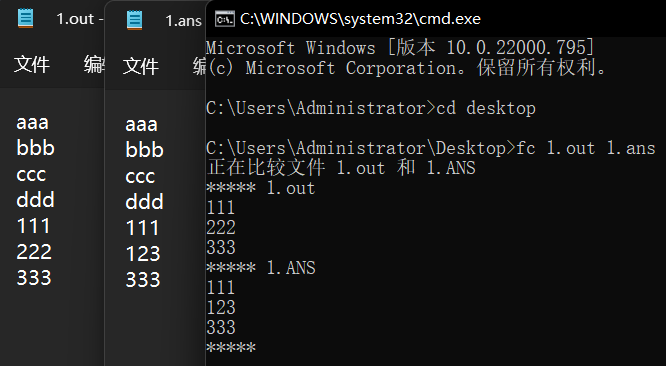1 set
1.1 set 的定义
1
2
| set<int>s;
set<int>::iterator it;//定义迭代器
|
1.2 set 的各种函数
1
2
| s.begin(); // 返回第一个元素的迭代器
cout<<*s.begin(); // 输出最小值
|
1
2
3
4
5
6
7
8
9
10
11
12
13
14
| s.end(); // 返回最后一个元素的下一个的迭代器
set<int>::iterator it=s.end();
it--;
cout<<*it; // 输出最大值
cout<<*(s.end()-1); // 非法操作:set的迭代器不是一个数值,不能做减法。
// 因为set不支持下标访问,它是一棵树(堆)。
// 而it--是支持的。
//与vector和数组的排序比较
vector <int> a;
sort(a.begin(),a.end()); // end()不用加一
const int maxn=1e5;
int arr[maxn];
sort(arr,arr+maxn+1); // 需要手动加一
|
1
2
3
| s.rbegin(); // 倒着的最后一个迭代器
// 所以输出最大值不用 end() ,可以写成:
cout<<*s.rbegin();
|
1
2
3
4
| s.erase(5); // 把 s 中的 5 删除(值)
s.erase(s.upper_bound(5)); // 删除第一个大于5的元素(迭代器)
s.erase(s.begin()); // 把 s 中的最小值删除(迭代器)
s.erase(*s.begin()); // 把 s 中的最小值删除(值,等价于上面一行)
|
1
2
| set<int>::iterator it = s.find(3);
//如果有 3 就返回 3 的迭代器,否则返回 s.end() 。
|
1
2
3
4
| s.count(3);
// 返回s中有几个3
// 注意:返回值只会是 0 或 1 ,因为 set 会自动去重!
// 所以 find 可以代替 count ,因为 find 还可以返回迭代器,比 count 更好!
|
1
2
3
4
5
6
| // 其他函数
s.insert();
s.size();
s.clear();
s.lower_bound(); // 大于等于
s.upper_bound(); // 严格大于
|
set 可当作“双端去重优先队列”用,因为内部是从小到大排序的。
2 multiset
2.1 定义方式
真正的“双端优先队列”。
1
| muiltiset<int>ms; // 可重集合
|
2.2 内建函数
1
2
3
4
| ms.count(3); // 返回 3 的出现次数
ms.erase();
// erase() 函数,如果传入一个值,会删掉所有这个值的元素;
// 如果传入一个迭代器,那么只会删去这个迭代器的元素。
|
其它函数和 set 一样,不过多赘述。
3 map
3.1 基础知识
1
2
3
4
5
6
7
8
9
10
11
| map<int,int>m;
m.insert({5,6}); // 等价于 m[5]=6;
m.insert({5,7}); // 等价于 m[5]=7;
cout<<m.count(5)<<endl; // 输出 1 ,因为已经被覆盖了
cout<<m.count(6)<<endl;
if(m[6]==0){
cout<<"没有6"<<endl;
}
if(m.count(6)){
cout<<"有6"<<endl;
}
|
想一想:上面的代码会输出 有6 还是 没有6 呢?
正确输出为:
注意,在执行第6行引用了 m[6] ,此时 map 会自动为 m[6] 对应一个 0 ,所以在下面的代码中出现了 {6,0} 的键值对。
3.2 lower_bound()
1
2
3
4
5
6
7
8
9
| // map 的 lower_bound() 方法
map<int,int>m;
m[10]=20;
m[12]=7;
m[7]=6;
map<int.int>::iterator it=m.lower_bound(8); // 找到第一个键值大于 8 的
cout<<it->fisrt<<" "<<it->second<<endl; // 与下面的等价
cout<<(*it).first<<" "<<(*it).second<<endl;
// 注意:不能使用 *it.first ,会报错,因为 * 的优先级比 . 低,而 first 没有 * 操作。
|
4 默认数据类型小讲堂
1
2
3
4
5
| 1
1ll
1ull
1<<10
1<<40ll // 爆掉,因为对 int 左移
|
1
2
3
4
5
6
7
8
| cout<<10000000000<<endl;
// 输出 10000000000,而没有爆 int ,因为 c++ 会在你写下数字的时候自动选择数据类型
cout<<1000000*1000000<<endl;
// 会爆掉
cout<<1000000ll*1000000<<endl;
// 不会爆掉
|
5 比较大样例输出正确性
5.1 使用 Hash
1
| certutil -hashfile <filepath>
|
这能得到两个文件的哈希值。
注意行末的换行,如果你的程序输出文件比大样例多/少了一个换行,哈希值也会完全不一样。
5.2 使用 fc 命令
1
| fc <filepath1> <filepath2>
|
如图:
6 位运算
lowbit(x) = x & -x;- 全排列
x 的二进制子集:
1
2
3
| for(int i=x;i;i=x&(i-1)){
cout<<i<<endl;
}
|
7 排序
7.1 常见的排序
- 冒泡排序( $n$ 趟,每趟从前往后,当前大就交换相邻)
- 计数排序(排结构体时,用邻接表限制插入排序,稳定)
- 选择排序(每次找到最大的,从很远的位置换过来,不稳定)
- 插入排序(复杂度 $O(N^2)$ 无法优化;但省内存;反冒泡,稳定)
1
2
3
4
5
6
7
8
| // 插入排序示例
for(int i=1;i<=n;i++){
for(int j=i;j>=2;j--){
if(a[j]>a[j-1]){
swap(a[j],a[j-1]);
}
}
}
|
- 快速排序(分治,用了分治的思想,不能说用了递归的思想;时间复杂度不稳定,排序不稳定)
- 归并排序(分治,稳定, $O(nlogn)$ ,时间复杂度也稳定)
- 基数排序(优先级低到高,从个位、十位到百位……排序, $O(nlgn)$ ,基于计数排序,稳定)
- 桶排序(分成一些范围的桶,如1~10,11~20……,然后对每个桶内再进行排序,👎)
- 堆排序(不稳定)
- 希尔排序(不稳定,👎)
7.2 关于比较次数
- 求最大/小值: $n-1$ 次。
- 冒泡排序/选择排序: 第 $i$ (从 1 开始计数)趟比较 $n-i$ 次。
- 通常代值 $1$, $2$ 。
8 存图 - 链式前向星
优点:常数更小
以下代码转自 https://blog.csdn.net/sugarbliss/article/details/86495945 :
1
2
3
4
5
6
7
8
9
10
11
12
13
14
15
16
17
18
19
20
21
22
23
24
25
26
27
28
29
30
31
32
33
34
35
36
37
38
39
40
41
42
43
44
45
46
47
48
49
50
51
52
53
54
55
56
57
| #include<bits/stdc++.h>
using namespace std;
const int maxn = 1005;//点数最大值
int n, m, cnt;//n个点,m条边
struct Edge
{
int to, w, next;//终点,边权,同起点的下一条边的编号
}edge[maxn];//边集
int head[maxn];//head[i],表示以i为起点的第一条边在边集数组的位置(编号)
void init()//初始化
{
for (int i = 0; i <= n; i++) head[i] = -1;
cnt = 0;
}
void add_edge(int u, int v, int w)//加边,u起点,v终点,w边权
{
edge[cnt].to = v; //终点
edge[cnt].w = w; //权值
edge[cnt].next = head[u];//以u为起点上一条边的编号,也就是与这个边起点相同的上一条边的编号
head[u] = cnt++;//更新以u为起点上一条边的编号
}
int main()
{
cin >> n >> m;
int u, v, w;
init();//初始化
for (int i = 1; i <= m; i++)//输入m条边
{
cin >> u >> v >> w;
add_edge(u, v, w);//加边
/*
加双向边
add_edge(u, v, w);
add_edge(v, u, w);
*/
}
for (int i = 1; i <= n; i++)//n个起点
{
cout << i << endl;
for (int j = head[i]; j != -1; j = edge[j].next)//遍历以i为起点的边
{
cout << i << " " << edge[j].to << " " << edge[j].w << endl;
}
cout << endl;
}
return 0;
}
/*
5 7
1 2 1
2 3 2
3 4 3
1 3 4
4 1 5
1 5 6
4 5 7
*/
|
9 概率与期望
打靶问题: $n$ 个靶子,每个靶子给一个命中概率 $a[i]$ (表示 $a[i]$ 分之一,问期望多少次能够连续命中 $n$ 个靶子。
1
2
3
4
| for(int i=1;i<=n;i++){
ans[i]=(ans[i-1]+1)*a[i];
// 走到第 i 个靶需要付出代价
}
|
打靶问题2: $n$ 个靶子,每个靶子给一个命中概率 $\frac{a[i]}{b[i]}$ ,问期望多少次能够连续命中 $n$ 个靶子。
1
2
3
4
| for(int i=1;i<=n;i++){
ans[i]=(ans[i-1]+1)*b[i]*inv[a[i]];
// 走到第 i 个靶需要付出代价
}
|
